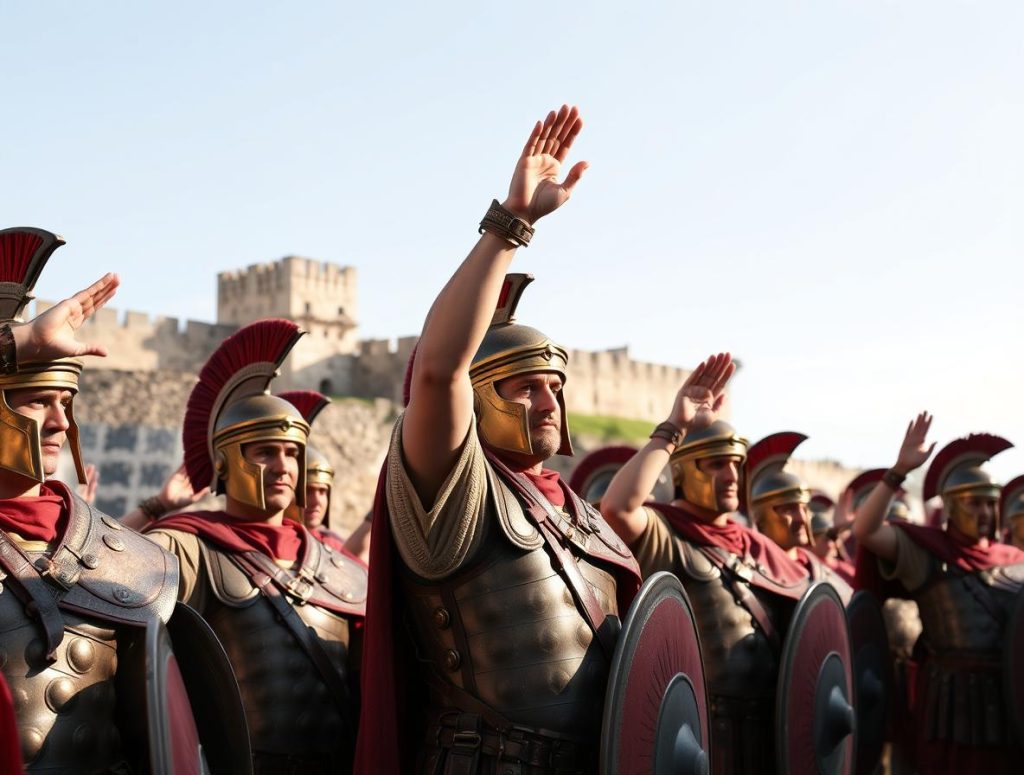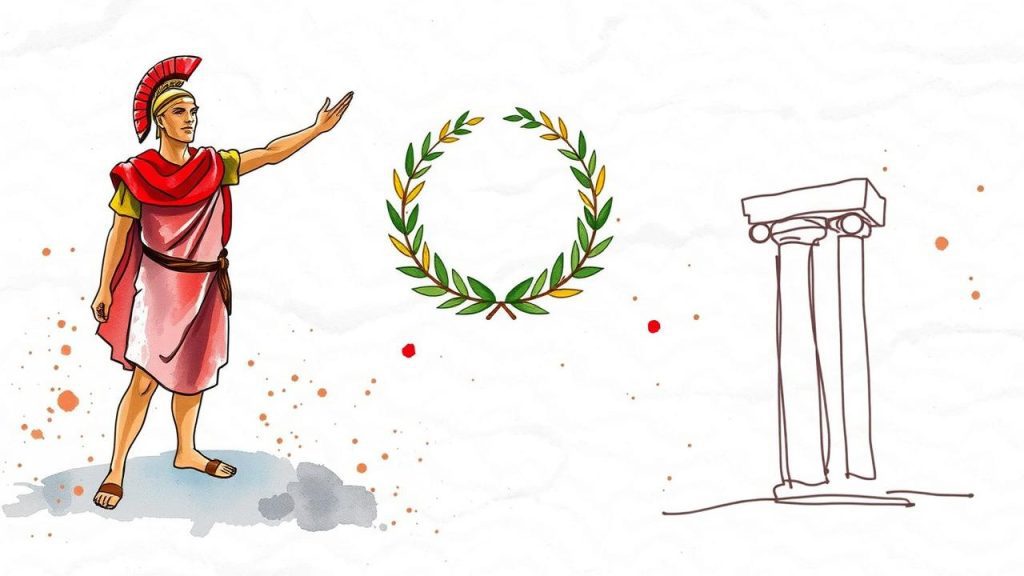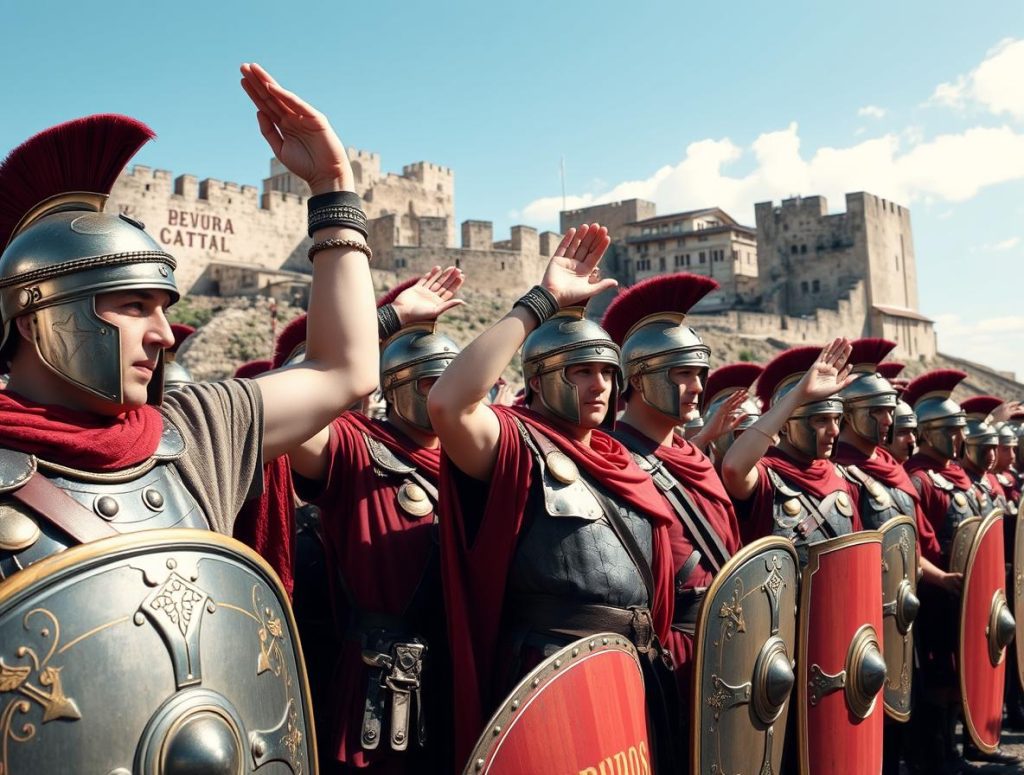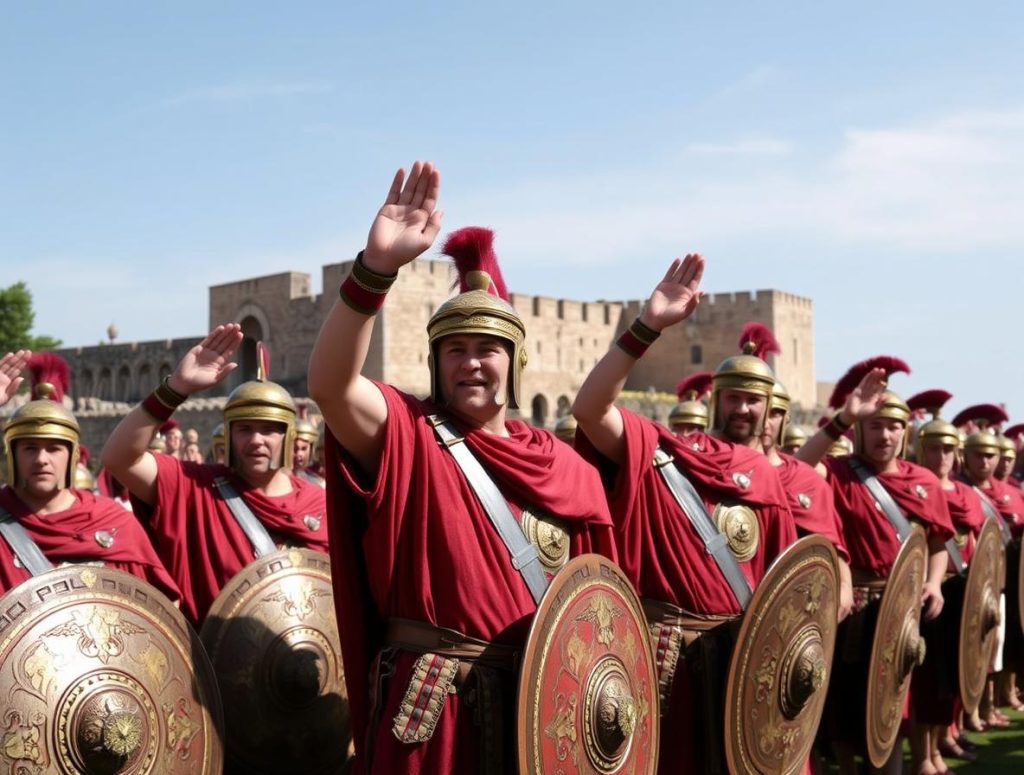The Roman military salute has origins as a form of greeting among soldiers. By raising the arm, soldiers showed respect and recognition. In a military context, saluting was a way to show respect for superiors and foster unity among the troops. This gesture symbolized loyalty to the Roman state and reinforced discipline within the legions, essential for their success. Later, this salute inspired other military cultures but was sometimes misinterpreted by modern political movements. Even today, it represents authority and respect in military contexts similar to those of Rome, revealing its enduring legacy.
Origins of the Roman military salute

The Roman military salute finds its origins in the need for soldiers to recognize and respect each other mutually. By raising the arm, they expressed not only a greeting but also a sign of deference towards their superiors. This gesture helped to strengthen the bonds among members of the same legion, thereby promoting communication and cohesion.
In a military context where discipline and order were paramount, the salute became an essential element during gatherings or inspections. For example, during troop reviews, each soldier saluted his commander by raising his arm as a sign of respect, thus illustrating the importance of hierarchy within the Roman armed forces.
In short, the Roman military salute was more than a simple gesture; it was a declaration of loyalty to Rome and its values, which shaped the military culture of the time.
Military Context of the Salute

The Roman military salute is rooted in a military context where discipline and respect were paramount. Within the ranks of the legions, saluting a superior was a way to affirm the hierarchy and demonstrate loyalty to the Roman Empire. This gesture also facilitated communication among soldiers, especially during gatherings or inspections. For example, during a troop review, a simple arm movement could strengthen the sense of unity and camaraderie among the soldiers. Thus, the salute was not just a formality, but an expression of devotion to the Roman state and its leaders, illustrating the solidarity of the legions that contributed to their military success.

Cultural significance of the gesture
The Roman military salute gesture holds a profound cultural significance that goes beyond the simple military context. This gesture, by raising the arm, symbolized not only respect towards superiors but also an unwavering loyalty to ancient Rome and its institutions. It embodied the unity and discipline of the Roman legions, essential elements that contributed to their success on the battlefield.
In the context of Roman society, the salute was a way to affirm one’s identity and belonging to a larger group. Soldiers, by saluting, expressed their commitment to the Republic and later, the Empire. This created a strong social bond among soldiers, fostering a spirit of camaraderie and solidarity. For example, during gatherings or military parades, the salute became a means to demonstrate the collective strength and order prevailing within the troops.
Moreover, this gesture also has symbolic implications. It represents the military hierarchy, where each level of command is respected and acknowledged. It is a way to show that every soldier, from the simple legionary to the general, has a crucial role in the functioning of the military machine. Thus, the Roman military salute transcends mere formality, becoming a symbol of honor and duty towards the homeland.
- Reflection of Roman values
- Expression of loyalty to the State
- Recognition of military ranks
- Unity among soldiers
- Connection with religious rituals
- Influence on civilian interactions
- Symbolization of peace and respect
- Use in official ceremonies
Influence on Later Cultures
The Roman military salute has left an indelible mark on many cultures that followed its prosperity. Indeed, this act of greeting was adopted and adapted by armies such as those of the Byzantine Empire, where it continued to symbolize respect and hierarchy within the military forces. Over the centuries, the gesture found its place in various modern military contexts, illustrating the importance of respect towards superiors and discipline within the ranks. For example, in contemporary armies, the salute is often the first demonstration of respect during official ceremonies or inspections, reflecting values inherited from the Roman era. Outside the military domain, elements of the Roman salute are also found in civic contexts, where it serves to express a form of respect towards institutions and figures of authority. This shows how a simple gesture, such as the military salute, can transcend time and space, influencing practices that endure to this day.

Modern Interpretations of Salvation
The Roman military salute has been reinterpreted in modern contexts, often outside of its original intention. In the 20th century, certain political movements, notably fascism, adopted similar gestures, creating a negative association that still persists today. This appropriation has led to debates about the meaning of the salute and its legacy, linking it to controversial ideologies. Moreover, in modern armies, the salute continues to be a symbol of respect, evoking discipline and hierarchy. Today’s military personnel often salute by raising their hand to their forehead, a gesture that recalls the ancient Roman salute but is stripped of its historical connotations. Thus, although the gesture is rooted in history, its modern interpretations vary widely depending on context and usage.
Symbol of authority in the armies
The Roman military salute became a symbol of authority and respect within the armies. By raising the arm, soldiers demonstrated not only their obedience but also their dedication to their superiors and the state. This gesture, rooted in military tradition, embodies essential values such as discipline, hierarchy, and respect, which were fundamental for the proper functioning of the Roman legions.
In modern military contexts, the salute continues to play a crucial role. For example, during official ceremonies or military reviews, the salute is a mark of respect towards senior officers and institutions. It reminds every member of the army of the importance of the chain of command and the duty of loyalty to their country.
Moreover, in certain cultures, the gesture has broadened its meaning to symbolize authority in civilian contexts. For instance, political figures or community leaders may also use a similar gesture to signify their position and respect towards their fellow citizens. Thus, the military salute, as a symbol of authority, transcends the military sphere and remains rooted in contemporary culture.

Historical Accounts and Ancient Texts
Historical accounts and ancient texts provide valuable insights into the use and significance of the Roman military salute. Authors such as Livy and Caesar mentioned scenes where soldiers salute their officers, emphasizing the importance of this gesture within the military hierarchy. For example, in “De Bello Gallico,” Caesar describes how his soldiers respectfully salute their commanders during assemblies. Additionally, inscriptions on monuments and steles attest to the use of this salute in ceremonial contexts. Interpretations of these texts may vary, with some scholars suggesting that the salute was a symbol of loyalty not only to superiors but also to Rome itself. These elements show how the military salute evolved while remaining rooted in the core values of the Empire.
| Éra | Historical context | Meaning |
|---|---|---|
| Roman Republic | The soldiers saluted to show respect and order. | Recognition and respect towards superiors. |
| Roman Empire | The salute has become an essential military formality within the legions. | Unity and discipline of the troops. |
| Bizantin | The gesture was influenced by the Roman tradition, which persisted within the Byzantine army. | Intact authority symbolism in military institutions. |
| Modern era | The military salute is practiced in many armies around the world, a legacy of ancient Rome. | Gesture of loyalty and respect. |
| 20th century | Controversial Uses of Salutes by Political Movements. | Stigmatization and debate around cultural significance. |
Inheritance of the Roman salute
The Roman salute, with its deep military roots, has become a lasting symbol of the values of discipline and respect within the Roman Empire. This gesture, which involved raising the arm, represented not only a form of greeting but also allegiance to power and the state. Over the centuries, its legacy has manifested in the military traditions of many cultures, demonstrating the enduring nature of its meanings. For example, in modern armies, the salute is still used to establish relationships of respect between soldiers and their superiors. However, this gesture has also been misappropriated in controversial political contexts, raising debates about its interpretation and current use. Despite these issues, the Roman salute remains a powerful emblem of unity and loyalty, reflecting the values that shaped the identity of the Empire and continue to influence contemporary military practices.

Frequently Asked Questions
1. What is the origin of the Roman military salute?
The Roman military salute dates back to ancient traditions, where it was used to show respect and loyalty to superiors.
2. Why is the Roman military salute important in history?
This gesture symbolized order and discipline within the Roman army, playing a key role in communication between soldiers and their leaders.
3. This gesture symbolized order and discipline within the Roman army, playing a key role in communication between soldiers and their leaders.
Over the centuries, the salute was adopted by other military cultures, evolving to adapt to different contexts and meanings.
4. Is the Roman military salute still used today?
Yes, some aspects of the Roman military salute continue to influence modern military gestures in various armies.
5. What are the differences between the Roman salute and other military salutes?
The Roman salute is distinguished by its simplicity and symbolic nature, compared to more formal salutes present in other military traditions.
TL;DR The Roman military salute, which mainly consisted of raising the arm as a sign of respect, has origins deeply rooted in the military and cultural context of ancient Rome. This gesture symbolized loyalty to the Roman state and the unity of the legions. Its influence extended to many later cultures, while being adapted in modern military contexts. Although the salute is often associated with values of authority and discipline, modern interpretations highlight its controversial uses. Ultimately, the legacy of the Roman salute endures in today’s military practices.

